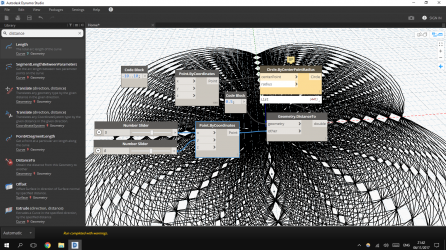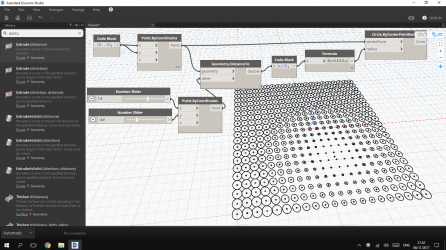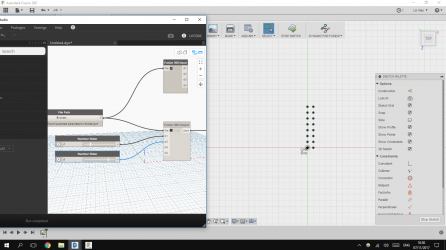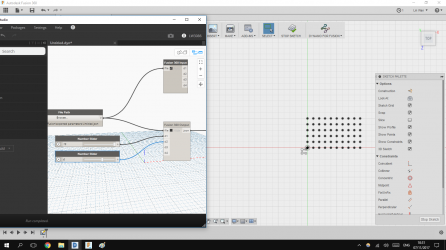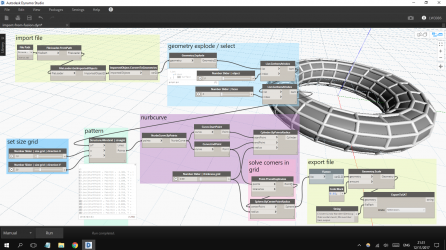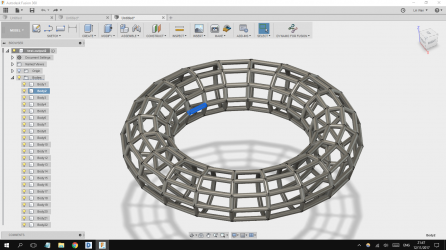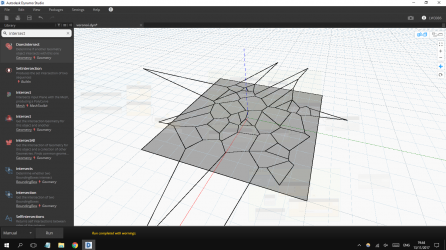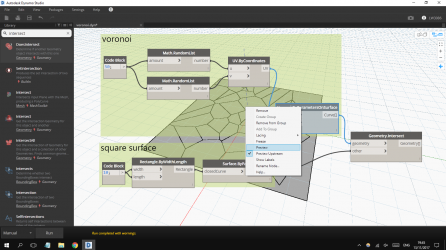week 6
Computational Couture.
Assignment | 31 oktober 2017
Develop or use an existing parametric model in order to design and rapid prototype your geometries using a digital fabrication method of your choice.
ref.: http://fabricademy.fabcloud.io/handbook/classes/05_computational.html
Visual logic
The lectures of this week were focused on introducing Grashopper. My problem with Grashopper is that you need Rhino as foundation for the plugin to function. And in my case, I can only install the trial version once. So, instead I asked around for alternatives in visual parametric logic.
- Blender plugin http://nikitron.cc.ua/sverchok_en.html
- Fusion360 - Pyton or C++ - Script and Add-In http://help.autodesk.com/view/fusion360/ENU/?guid=GUID-9701BBA7-EC0E-4016-A9C8-964AA4838954
- BIM FreeCAD https://www.freecadweb.org/
Dynamo
I am a fan of Fusion360 design environment, so my first choice landed on Dynamo, which is also from Autodesk. I found out that there are 2 versions of Dynamo. One is the stand alone open source version and the other the (payed) “Pro” version.
Dynamo is similar to Grashopper, but instead it's possible to connect to Revit (architectural design software). Yet recently (since may), there is now the option available of connecting Dynamo to Fusion360. The other thing that got my interest, is that it's a stand alone sandbox software. So getting to know a specific design software is not a necessity. Dynamo can output .SAT file format.
First project
- Download Dynamo Studio : https://www.autodesk.com/products/dynamo-studio/overview
- Fusion360 to Dynamo plugin : https://apps.autodesk.com/FUSION/en/Detail/Index?id=74731490955641349&appLang=en&os=Win64
- Youtube - video introduction to dynamo + first tutorial : https://www.youtube.com/watch?v=_na68eG_jj4
Export to SAT
Once the model is done you need to add a piece of visual logic to be able to export to SAT. For some reason I was not able to import SAT file with vectors only into Fusion360. But extruding the circles a tiny bit, esentially turning them into solids, did the trick.
https://www.youtube.com/watch?v=R0bIiLvIWeI
Dynamo to Fusion Plugin
https://apps.autodesk.com/FUSION/en/Detail/Index?id=74731490955641349&appLang=en&os=Win64
In Fusion360 it's already possible to add parametric values to your model. But in complex design this list can become long and complex. As solution you can download (via the Fusion app store) a plugin to connect your model to Dynamo studio. What Dynamo studio does is importing all your parameters, so you can visually tweak your setup. However, I have not tried if Dynamo studio is a requirement or if the open source Dynamo would function in this workflow too. What is (currently) not possible, is to start to generate a model in Dynamo and then continue in Fusion360. But off course you could export and then import it as a workaround.
SAT file to Fusion360
A valid workflow is to generate a model in Dynamo, export as SAT and import to Fusion360 as solid. (File > New design from file).
Dynamo generated grid structure
Interesting clip showing how to generate a grid structure on a model.
https://www.youtube.com/watch?v=2d5hKSAsB68 & https://www.youtube.com/watch?v=i_iZtJCGfC0
In the clip you see the designer switching back and forth between the 2 software's. Interesting, yet there is no “official” app available to recreate this. However, I know it is possible to use either Phython of C++ scripting to make your own plugin / add on. As a simple workaround you can also work with importing and exporting the SAT file format.
The other thing to note, is that the generated design in dynamo, did not merge together. The torus shape is separate from the pipes and from the “corner” spheres. So in Fusion360 you have to import 3 files to get to the same point. However that does leave you with many possibility's for continuation of the design.
Toggle preview
http://dynamoprimer.com/en/05_Geometry-for-Computational-Design/5-1_geometry-overview.html
https://forum.dynamobim.com/t/voronoi-how-to-offset-fillet-cells/8377
While getting to know Dynamo I stumbled across the problem that the generated voronoi pattern was not staying inside it's bounding box.
Solution was the realization that you need to turn off the preview of some parts of the logic's design. What Dynamo does, is generating each step of the logic on top of each other. And while a intersect is stated in the logic, it's hard to visually recognize it. Because the uncut voronoi is on the same spot with the intersected voronoi, thus it appears like nothing has happened.
